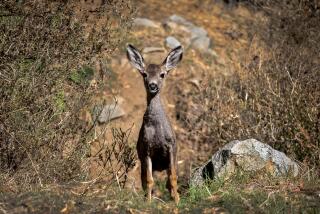Fowl Are Out of Bounds
- Share via
At Woodley Lakes Golf Course in Van Nuys, the Canada geese don’t seem to bother the golfers, and the golfers don’t bother the geese.
But Rosemarie White, president of the Canada Goose Project, thinks that environmentalists and city officials need to sit down before tensions between geese and people escalate, and find better ways to manage the waterfowl.
White, who lives in Valley Village, is concerned because the Canada geese in the Sepulveda Dam Recreation Area seem to prefer the busy golf course on the west side of Woodley Avenue to the designated wildlife area on the east side.
Last week, one breeding pair of Canada geese crossed six lanes of traffic on Woodley Avenue, its brood of five goslings in tow. The geese relocated next to one of the man-made lakes on the golf course.
According to White, at least 45 adult geese and 28 goslings are living among the sand traps and fairways.
“This is the second year that this family migrated from the wildlife area to the golf course,” said White, whose organization tracks fluctuations in the goose population.
White said she worries that the geese’s preference for water hazards puts the migratory birds on a potential collision with hazards of another kind. In other cities, including Seattle, thousands of Canada geese have been killed by government decree as public nuisances, she said.
The potential danger to geese is especially great now, White said, because the U.S. Fish and Wildlife Service has proposed turning more responsibility for management of the species over to the states--which may lead to a loosening of hunting regulations.
White has been meeting with the Los Angeles Department of Recreation and Parks, which manages the golf course, to discuss ways to protect both geese and the interests of the golfers. So far, the relationship seems friendly on both sides.
Golf carts wind through the course, their drivers apparently unaware that goose eggs are being hatched among the bulrushes and under trees.
Stephen Moe, water manager for the recreation area, said he hears few complaints from golfers about the big, handsome birds.
“I think most of our golfers are pleased to see the wildlife,” said Moe. “I’m sure some golfers are slightly frustrated when their ball stops dead because of running into goose effluvia.”
Nationally, Canada geese are increasingly controversial. Their populations have been growing in recent decades, and many communities regard them as pests. The geese also have their champions, including White and Gregg Feigelson, director of the New York-based Coalition to Prevent the Destruction of Canada Geese.
On its Web site (www.icu.com /geese), Feigelson’s group urges supporters to notify the Fish and Wildlife Service of their opposition to its proposed regulation extending the goose-hunting season and allowing other actions that would reduce the number of resident Canada geese.
“This would be an all-out war on Canada geese,” Feigelson said.
The federal agency puts the resident U.S. goose population at 3.5-million birds.
The Fish and Wildlife Service has been holding public hearings on the proposal in 11 states, but California is not one of them. A decision is expected by fall.
White’s Canada Goose Project plans to give Moe and other Recreation and Parks personnel an award--they’re calling it the Bo Peep Award--for shepherding the local geese and stopping traffic while they crossed Woodley Avenue.
She said she is hopeful that all the interested parties can find a way to keep the geese from becoming an issue at Woodley Lakes.
“It’s not a problem now,” she said. “I would like to sit down with the city agency and invite in other organizations that are helping to find solutions to the problem of migratory birds taking up residence.
“The solution is not to kill the animals. The solution is to look at the causes first and establish habitat away from the [heavily used] parks that’s compatible with the animals’ needs.”
Most observers blame habitat destruction for increasing the sometimes-abrasive contact between geese and humans.
“Over the last 100 years, man has destroyed over 95% of the wetlands areas along the Pacific flyway, so these migrating birds don’t have a place to rest and recuperate during their seasonal journey,” Moe said.
White said planting more forage for the geese in the wildlife area might lure them away from the golf course, which now functions as a lavish buffet of clover and grasses.
Clashes between humans and wildlife will grow more common, she predicted, if communities don’t recognize the need to dedicate more open space as habitat for urbanized species such as Canada geese.
Dan Yparraguirre, a waterfowl biologist with the California Department of Fish and Game, said the state does not relish assuming more responsibility for the geese, if only because of increased bookkeeping.
He, too, thinks habitat destruction has created the current situation. “There are thousands of Canada geese in almost every county of our state now,” he said. “It’s a byproduct of human development.”
Issuing more permits to hunt geese is not a solution, at least in urban areas, he said. “I live in the city. I don’t want hunters in my backyard.”
Many communities are looking for creative ways to balance human and wildlife needs, he said. “But I’m afraid that this is one problem where there may or may not be a perfect solution.”
More to Read
Sign up for Essential California
The most important California stories and recommendations in your inbox every morning.
You may occasionally receive promotional content from the Los Angeles Times.










